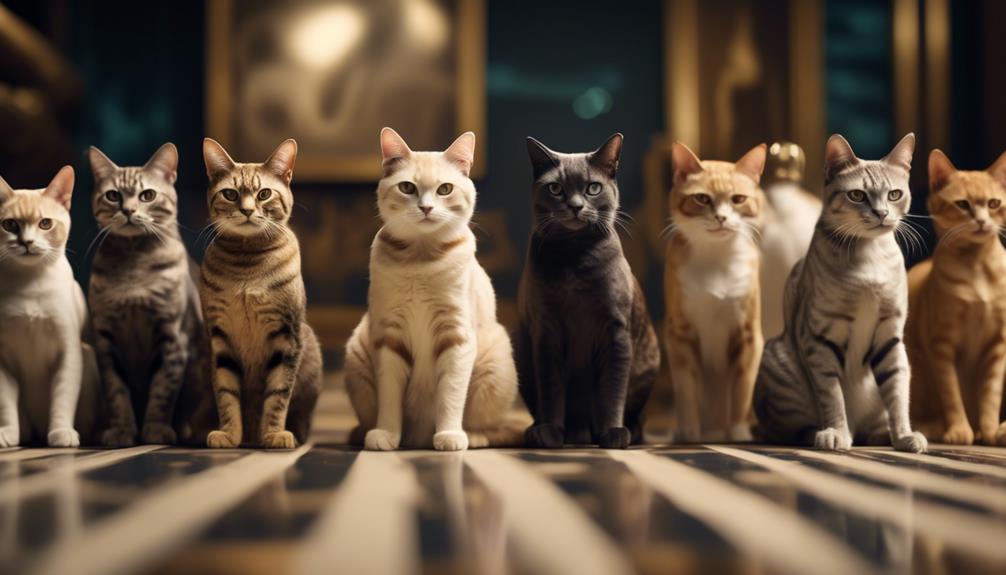The evolutionary journey of domesticated cat breeds holds a wealth of insights into the complex interplay between human intervention and natural selection.
From the enigmatic origins of ancient feline companions to the deliberate breeding practices that have shaped the diverse array of cat breeds we see today, the evolution of domestic cats provides a fascinating lens through which to explore the dynamics of genetic adaptation and behavioral traits.
As we uncover the three best insights into this evolutionary process, we gain a deeper understanding of the intricate relationship between humans and their feline counterparts, shedding light on the remarkable transformations that have occurred over millennia.
Key Takeaways
- Domestication of cats occurred around 9,000 years ago in the Near East region, marking the beginning of a unique relationship between humans and cats.
- Selective breeding techniques have resulted in a diverse array of cat breeds, with appearance, temperament, and behavior being key factors in the breeding process.
- Domestic cat breeds have undergone genetic adaptations through selective breeding, leading to distinctive physical and behavioral traits such as coat color and pattern, as well as sociability and activity levels.
- Understanding cat breed evolution enhances our understanding of genetic adaptation and behavioral traits, shedding light on the remarkable transformations that have occurred over millennia.
Ancient Origins of Domestic Cats
The ancient origins of domestic cats can be traced back to the Near East region, where evidence suggests that the domestication of these feline species occurred around 9,000 years ago. This pivotal moment in history marked the beginning of a unique and enduring relationship between humans and cats.
The transition from wild to domesticated felines brought about a significant shift in the roles of these animals, from hunters of pests to valued companions. Through selective breeding and cohabitation, humans have shaped the evolution of domestic cats, resulting in a diverse range of breeds with distinct physical and behavioral traits.
The process of domestication not only transformed the genetic makeup of cats but also influenced their social dynamics. The bond between humans and cats has evolved over millennia, leading to the development of feline companionship as we know it today.
Understanding the ancient origins of domestic cats provides valuable insights into the deep-rooted connection between humans and these enigmatic creatures, shedding light on the enduring appeal and significance of feline companionship in human society.
Selective Breeding and Cat Domestication
Having been shaped by millennia of selective breeding, the domestication of cats has resulted in a diverse array of breeds with distinct physical and behavioral characteristics. Selective breeding techniques have played a pivotal role in shaping the evolution of various cat breeds. Breeders have selectively chosen cats with specific desirable traits, such as appearance, temperament, and behavior, to propagate those traits in subsequent generations. This process has led to the development of breeds with predictable characteristics, allowing individuals to choose a cat that best fits their lifestyle and preferences.
Cat behavior studies have also contributed to the understanding of how selective breeding has influenced the domestication of cats. Through research and observation, scientists have gained insights into how certain behaviors have been accentuated or altered through selective breeding. These studies have provided valuable information for breeders to make informed decisions when selecting cats for breeding purposes.
Genetic Adaptations in Domestic Cat Breeds
Shaped by centuries of selective breeding, domestic cat breeds have undergone genetic adaptations that have led to the emergence of distinctive physical and behavioral traits. Genetic mutations have played a crucial role in the development of various breed-specific characteristics. These mutations have resulted in phenotypic diversity, including differences in coat color, pattern, and texture, as well as variations in body size and shape.
Furthermore, genetic adaptations have influenced behavioral traits such as sociability, territoriality, and activity levels in different cat breeds.
The genetic adaptations in domestic cat breeds have also contributed to breed diversity, leading to the wide range of feline companions we see today. Understanding these genetic adaptations is essential for breeders, veterinarians, and cat owners, as it can provide insights into the predisposition of certain breeds to specific health conditions. Additionally, it can aid in the development of targeted breeding programs aimed at preserving desirable traits and minimizing the expression of harmful genetic mutations.
Frequently Asked Questions
What Are Some Common Health Issues That Domestic Cat Breeds Face as a Result of Selective Breeding?
Common health issues in domestic cat breeds due to selective breeding include respiratory problems, heart conditions, and orthopedic issues. This is often attributed to reduced genetic diversity and modern breeding practices focusing on specific traits.
How Has Human Interaction and Influence Affected the Evolution of Domestic Cat Breeds Over Time?
Human influence has profoundly shaped the evolution of domestic cat breeds through selective breeding. Interactions with humans have led to genetic diversity, impacting the physical and behavioral traits of these breeds, illustrating the complex interplay between human intervention and feline evolution.
Are There Any Specific Behavioral Adaptations That Domestic Cat Breeds Have Developed as a Result of Their Interactions With Humans?
Domestic cat breeds have developed specific behavioral adaptations due to human interaction. Through genetic diversity and selective breeding practices, traits such as sociability, communication, and problem-solving have emerged, reflecting the dynamic influence of human interaction on feline behavior.
What Role Did Environmental Factors Play in the Evolution of Different Domestic Cat Breeds?
Environmental factors have played a crucial role in the evolution of different domestic cat breeds. Genetic diversity, evolutionary pressures, and natural selection have influenced the adaptation of cats to varying environments, leading to diverse physical and behavioral traits.
How Have Modern Breeding Practices Impacted the Genetic Diversity of Domestic Cat Breeds?
Modern breeding practices have significantly impacted the genetic diversity of domestic cat breeds. Selective breeding for specific traits has led to reduced genetic variation, potentially contributing to health issues within certain breeds. Efforts to preserve genetic diversity are crucial.


